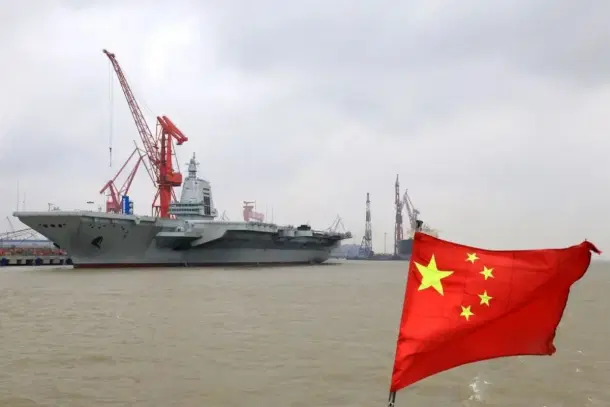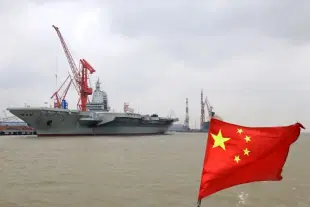World
As South China Sea Heats Up, Beijing Commences Trials Of Its Third Aircraft Carrier Fujian
Ujjwal Shrotryia
May 02, 2024, 01:07 PM | Updated 02:08 PM IST
Save & read from anywhere!
Bookmark stories for easy access on any device or the Swarajya app.


As tensions in the South China Sea escalate, China is intensifying the pressure. Its third aircraft carrier, 'Fujian', began its maiden sea trials yesterday (1 May) to test out whether all installed systems are working as they should be, and under the required operating parameters.
According to reports, Fujian left the Shanghai Jiangnan Shipyard yesterday morning for trials.
This occurs amid escalating rivalry between China, the US, and its allies in the South China Sea. Just a day before yesterday (30 April), the Chinese Coast Guard rammed and used water cannons against two Philippine supply ships, damaging their radars and satellite communications equipment.
These vessels were delivering food, water and supplies to fishermen at Scarborough Shoal.
For the past year, the Philippines and China have been engaged in various skirmishes over Scarborough Shoal and Second Thomas Shoal, both claimed by China under its imaginary Nine-dash line, which the Philippines, and, even the International Court of Justice (ICJ) reject.
The United States, along with the Philippines, France, and Australia, are conducting their largest-ever exercises in western Philippines, involving over 16,000 military personnel in the region.
In response, the Chinese conducted their own military exercise.
The US has also deployed the Typhoon ground-based long-range missile system in the Philippines, capable of firing Tomahawk land-attack cruise missiles and SM-6 air defence missiles.
The sea trials of the third 85,000-tonne 'Fujian' aircraft carrier add another dimension to the already complex and volatile situation in the South China Sea.
The quick operationalisation of the third aircraft carrier will provide a significant capability boost to China's People's Liberation Army Navy (PLAN). China, has in the span of a decade, manufactured and put to sea two aircraft carriers which is in itself a no mean feet.
Unlike the ski-jump aircraft launch system of the earlier two carriers, Liaoning (ex-Varyag, bought from Ukraine) and Shandong, Fujian will be the first flat-top Chinese carrier with an Electromagnetic (EMALs) catapult launching system.
The catapult launching system allows Fujian to launch heavy aircraft like KJ-600 Airborne early warning and control systems (AWACS) and fighter jets with their full load. It will be able to carry more than 60 aircraft, including J-15 fighter jets, helicopters and the KJ-600 aircraft giving China another means to project power.
When the 5th generation J-31 fighter jets enter service with the PLAN, coupled with KJ-600 AWACS, both operating from Fujian, it will significantly enhance Chinese naval strike capabilities, beyond anything that its neighbours can field.
It is already brazening out protests from the Philippines, Taiwan, and Vietnam, sending hundreds of its militia and coast guard vessels to enforce its claims harassing their fishing vessels. These new capabilities will make China even more confident in getting away with whatever actions it wishes to do with its neighbours, whether legal or illegal.
Furthermore, the Chinese has plans to induct five to six aircraft carriers by 2035.
That will make China even more bold.
It is expected that in the next five to 10 years, China will station a carrier battle group (CBG) in the Indian Ocean Region (IOR) to challenge the Indian Navy as the prime naval power in the region.
It hopes that the CBGs will safeguard its maritime sea lanes of communication (SLOCs) passing through the Malacca, Lombok, and Sunda straits, through which more than 80 per cent of Chinese cargo passes.
In preparation, it is gradually upgrading and constructing new naval infrastructure that can support the deployment of CBGs.
China already controls the Hambantota port in Sri Lanka on a 99-year lease and has a military base in Djibouti on the western edge of the Indian Ocean. It has accelerated the operationalisation of Kyaukphyu port in Myanmar and also gained access to Ream naval base in Thailand, on the eastern edge of the Indian Ocean.
As stated above, the Indian Navy, with its two aircraft carriers — INS Vikrant and Vikramaditya — will soon have to contend with China’s CBGs in the near future.
It has to make do with just 40-odd MiG-29K fighter jets, barely enough to form an air fleet for both carriers until the 26 Rafale-M arrives. The approval for the construction of another aircraft carrier, of the same design as Vikrant, is pending with Defence Acquisition Council (DAC).
DAC will only make the decision after the new government comes to power.
However, even if approval is granted now, the carrier will take another seven to eight years to build and an additional two to three years for trials and induction, approximately until 2035, by which time INS Vikramaditya will be nearing retirement.
That will leave the Indian Navy with just two aircraft carriers, against its historical requirement of three — one serving on each seaboard while the third under servicing.
It is therefore imperative for the new government to make a decision on the aircraft carrier as soon as possible, lest the Indian Navy is forced to contend with China’s CBGs with one hand tied behind its back.
Staff Writer at Swarajya. Writes on Indian Military and Defence.





